
Coronavirus
Technology Solutions
October 19, 2020
A BB Gun in Bear Country is Like a Cloth Mask at
a Rally
Daikin Sales are Down in 2020
but Steps Taken to Rebound
AAF Membrane Media
is an Option for COVID Mitigation
Mann+Hummel has Unique Cabin Air Filter
ProPublica Charts the Decline of the CDC
_____________________________________________________________________________
A BB Gun in Bear Country is Like a Cloth Mask at
a Rally
Grizzly bears are as tough to stop as the
coronavirus. Even relatively high powered guns
may not stop the charge. No one would recommend
a BB gun for protection. Yet a BB gun to stop a
bear is as illogical as a loose fitting
inefficient mask to protect against COVID.
When the guidance is to wear a mask without
specifying
the level of protection, it is equivalent
to telling people that any kind of gun will
protect them in bear country. The false sense of
security could be doing huge damage. Some
studies show that 70 percent of the COVID cases
occur in people who are wearing masks. This
coincidently ties into the likely efficiency of
a cloth ill-fitting mask. If everyone is wearing
inefficient masks you would expect only 20
percent better protection than if no masks were
worn.
Mask inefficiency is a subject many experts are
avoiding because they worry that this fact will
be used to persuade people not to wear masks at
all. Some experts such as Professor Osterholm of
the University of Minnesota express the opposite
view. He worries that people will feel safer
than they should and will venture into risky
situations with a false sense of security.
What is particularly puzzling is that no one
argues about the physics and yet there is no
major campaign to encourage use of efficient and
tight fitting masks.
·
Medical personnel in the best PPE are close to
100% protected against the virus even if the
virus load is extremely high.
·
If everyone wore this garb for four weeks the
virus would be gone.
·
The virus is only 100 nanometers or 0.1 microns
in diameter.
·
It is frequently carried on 1 micron and larger
droplets.
·
These droplets evaporate.
·
The salts remaining after evaporation vary in
size but are much smaller than the droplet.
·
Large droplets captured on the inside surfaces
of masks are either divided into smaller
droplets by air flow back and forth or they
evaporate.
·
Particles adhering to media surfaces will very
likely not become airborne but particles in
droplets which evaporate can penetrate the mask
or flow out the leaks around the mask periphery.
·
Most masks worn by the public are loose fitting.
The amount of air circumventing the media is
often 50% or more.
·
It is misleading to judge the mask fit by the
leakage of all particles. It is the small virus
which will act like perfume or cigarette smoke
and penetrate any opening.
·
Most masks have a very low efficiency on perfume
or cigarette smoke and therefore are just as
inefficient on viruses.
·
When you combine the virus which is inhaled
around
the periphery of the mask with the virus which
penetrates, it is likely that the total
efficiency is as low as 20%.
Inefficient Loose Fitting Cloth Mask

This is assuming that the wearer has the mask in
the proper position.
Efficient Tight Fitting Mask

An efficient tight fitting mask will only allow
3 percent of the virus to penetrate and 2
percent to be inhaled through the periphery.
It is very important that this mask knowledge be
continually assessed and debated. Engineers and
aerosol scientists cannot disregard the physics
just described. The one variable where the
medical community has superior knowledge is the
viability of the virus. Does the virus initially
captured in a large droplet become inactive as
the droplet evaporates and it becomes airborne?
The opposite seems be true with documented cases
of aerosol viability 24 hours after exhalation.
Does a massive instantaneous dose of virus cause
more harm than if that dose is metered out over
15 minutes?
There is some evidence that the opposite
is true. Some super spreader events such as the
Washington state choir imply that continuous
exposure over an hour is likely to cause
transmission.
If in fact reliance on cloth masks is as
dangerous as relying on a BB gun in bear
country, it is very important to gain a
consensus on the dangers. The daily alerts and
webinars included in Coronavirus Technology
Solutions provide a forum to analyze all
aspects in depth.
Click here for more information
Bob McIlvaine can answer your questions at
847 226 2391 or email
rmcilvaine@mcilvainecompany.com.
Daikin Sales are Down in 2020 but Steps Taken to
Rebound
2020 will be a down year for Daikin with sales
dropping 4
percent and profits down 20 percent.
|
|
Unit |
FY2015 |
FY2016 |
FY2017 |
FY2018 |
FY2019 |
FY2020 |
|
Net Sales |
billion yen |
2,043.7 |
2,044.0 |
2,290.6 |
2,481.1 |
2,550.3 |
2,400.0 |
|
Operating Profit |
billion yen |
217.9 |
230.8 |
253.7 |
276.3 |
265.5 |
198.0 |
|
Ordinary Profit |
billion yen |
209.5 |
231.0 |
255.0 |
277.1 |
269.0 |
198.0 |
|
Profit Attributable to Owners of Parent |
billion yen |
137.0 |
153.9 |
189.1 |
189.0 |
170.7 |
130.0 |
|
Earnings Per Share |
yen |
469.23 |
526.81 |
646.53 |
646.39 |
583.61 |
444.32 |
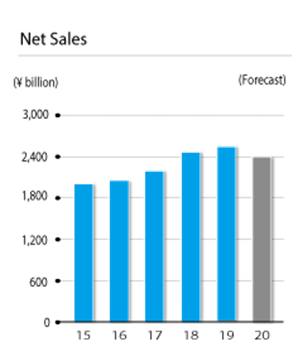
A number of
steps are being taken to deal with COVID.
They include the following:
Strengthening procurement, manufacturing,
inventory, and logistics globally
✓ We have responded to changes such as demand fluctuations and regulations on logistics and production by understanding information on procurement, production, and sales of the five global regions. This has enabled us to avoid opportunity loss and expand sales.
✓ To promote medium- to long-term development, we are built a strong, flexible SCM that extends globally.
Outperforming rivals in response to global
changes and declining demand; and strengthening
sales and marketing capabilities to increase
market share while maintaining selling price
✓ As demand declines, we are working closely with customers to meticulously capture demand and expand sales
✓
All five main air conditioning divisions are
expected to achieve higher sales than the
previous year in the second half. (Japan 101%,
Europe 107%, China 118%, Asia / Oceania 100%,
and the United States 100%)
Japan: We are aiming to further increase market
share for commercial use and gain the No. 1
share for residential use.
Europe: Expand sales for residential and
commercial use utilizing environmental
technology as we work to achieve a large sales
expansion of heat pump type heating systems.
China: In addition to offline sales utilizing
our unique sales network, we will promote online
and e-commerce sales. Annual sales are expected
to exceed the previous year as we develop best
practices in China to other regions.
Expanding sales of air and ventilation products; developing and launching new differentiated products; and creating solutions on a global level to thoroughly capture the growing demand resulting from greater awareness for air quality and ventilation
✓ In response to the growing interest in air quality worldwide, we were the first to introduce air quality and ventilation products. Sales of air quality and ventilation related products this year will be 160% year over year.
✓ Sales for residential air purifiers are expected to grow significantly by 205% year-on year. Production will start in Malaysia by the end of 2020, and we will also manufacture these products in Japan.
✓
As the leading air-conditioning manufacturer, we
have developed globally by determining the
future customer needs, quickly developing
products, and proposing solutions in becoming a
large-scale business. Japan: Expand the RA
lineup with built-in air ventilation function,
launch a new air purifier product, and introduce
a new heat exchanger that can be retrofitted.
Americas: Launch a UV light that disinfect heat
exchangers and construct a system to detect air
quality in air ducts. China: Introduce a
residential use heat exchanger and an air
purification system. Europe: Introduce a high
efficiency heat exchanger. Asia: Equip RA with a
high-performance filter, strengthen sales of air
purifiers.
Profitability is expected to quickly recover by
thoroughly implementing aggressive and
challenging measures. In 2022, we foresee a
return to profits at a pre-COVID-19 level.
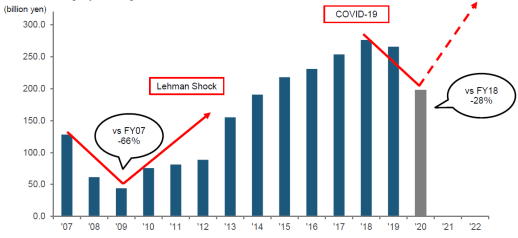
Daikin-AAF Flanders, the world’s largest
manufacturer of air filtration solutions,
operates production, warehousing and
distribution facilities in 22 countries across
four continents. With its global headquarters in
Louisville, Kentucky, AAF Flanders is committed
to protecting people, processes and systems
through the development and manufacturing of the
highest quality air filters, filtration
equipment and containment housings available
today.
Flanders was formed in April 2016, when American
Air Filter Co. Inc., doing business as AAF
International, acquired Flanders Corp., now a
wholly owned subsidiary. The combined company
offers comprehensive, innovative air filtration
solutions designed to remove and control
airborne particulates and gaseous contaminants
in residential, commercial, industrial,
cleanroom, transportation and nuclear power
applications.
AAF Membrane Media
is an Option for COVID Mitigation
McIlvaine is forecasting a big demand for HEPA
filters to capture virus particles. These
filters will be used in HVAC systems as well as
in room air purifiers. The membrane option has
some attractive features including
availability. compared to microglass. At
a Belgian cleanroom conference last year Dr Marc
Schmidt of AAF addressed the advantages of
membranes in HEPA filters. one advantage is the
high efficiency.
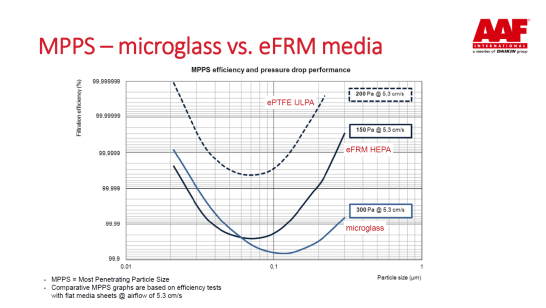
The lower pressure drop is also a big advantage.

A number of advantages
are presented
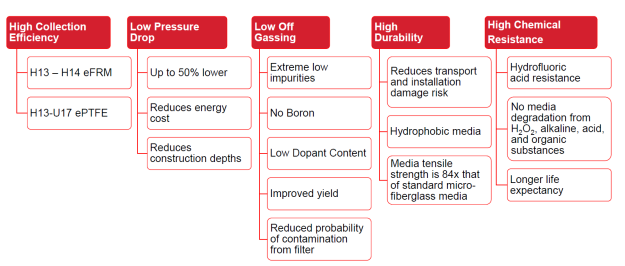
McIlvaine will continue to investigate the
membrane option and encourages input from our
subscribers.
Mann+Hummel has Unique Cabin Air Filter
MANN+HUMMEL has compiled various information on
protection inside the car by means of cabin
filters.
With a size of about 0.1 micrometers, the new
virus is roughly 500 times smaller than a human
hair. As a rule, however, the corona virus
adheres to larger droplets, such as those caused
by coughing or sneezing. These droplets are 10
to 1,000 times larger than the original virus.
Due to their size, they fall to the ground quite
quickly.
It is highly unlikely that a contaminated
droplet from the road surface will enter the
vehicle's cabin filter system from the outside
air. The probability of exposure to the virus
from an infected occupant inside the vehicle is
much higher.
Thorough cleaning of the outside air by a
high-quality cabin air filter is, in any case,
essential. This is especially true for frequent
drivers, allergy sufferers and accompanying
children. A cabin air filter cannot be
considered part of "personal protective
equipment", such as a face mask. However, it
does block irritating pollutants in traffic like
brake dust, harmful gases, and allergens like
pollen. A cabin filter can only perform these
meticulous cleaning actions properly if it is
replaced on a regular basis. This interval
varies by vehicle manufacturer, but generally
falls in the one to two year time period. Many
drivers are unaware of the cabin filter or the
benefits it offers, with average replacement
occurring only once in five years!
An innovation in cabin air filters from
MANN-FILTER is FreciousPlus. The filter blocks
unpleasant smells, and harmful gases such as
nitrogen oxides and ozone from the outside air,
while removing almost 100 percent of harmful
particles such as fine dust. With the help of
its third filter layer with biofunctional
coating, FreciousPlus stops allergens almost
completely and prevents bacteria and mold growth
on the filter.
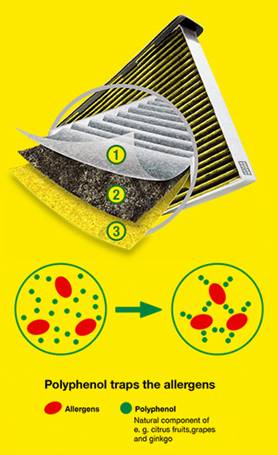
ProPublica Charts the Decline of the CDC
When the next history of the CDC is written,
2020 will emerge as perhaps the darkest chapter
in its 74 years, rivaled only by its involvement
in the infamous Tuskegee experiment, in which
federal doctors withheld medicine from poor
black men with syphilis, then tracked their
descent into blindness, insanity and death.
With more than 216,000 people dead this year,
most Americans know the low points of the
current chapter already. A vaunted agency that
was once the global gold standard of public
health has, with breathtaking speed, become a
target of anger, scorn and even pity.
How could an agency that eradicated smallpox
globally and wiped out polio in the United
States have fallen so far?
ProPublica obtained hundreds of emails and other
internal government documents and interviewed
more than 30 CDC employees, contractors and
Trump administration officials who witnessed or
were involved in key moments of the crisis.
Although news organizations around the world
have chronicled the CDC’s stumbles in real time,
ProPublica’s reporting affords the most
comprehensive inside look at the escalating
tensions, paranoia and pained discussions that
unfolded behind the walls of CDC’s Atlanta
headquarters. And it sheds new light on the
botched COVID-19 tests, the unprecedented
political interference in public health policy,
and the capitulations of some of the world’s top
public health leaders.
Senior CDC staff describe waging battles that
are as much about protecting science from the
White House as protecting the public from
COVID-19. It is a war that they have, more often
than not, lost.
Employees spoke openly about their “hill to die
on” — the political interference that would
prompt them to leave. Yet again and again, they
surrendered and did as they were told. It wasn’t
just worries over paying mortgages or forfeiting
the prestige of the job. Many feared that if
they left and spoke out, the White House would
stop consulting the CDC at all and would push
through even more dangerous policies.
To some veteran scientists, this acquiescence
was the real sign that the CDC had lost its way.
One scientist swore repeatedly in an interview
and said, “The cowardice and the caving are
disgusting to me.”
Collectively, the interviews and documents show
an insular, rigorous agency colliding head-on
with an administration desperate to preserve the
impression that it had the pandemic under
control.
Some of the key wounds were self-inflicted.
Records obtained by ProPublica detail for the
first time the cataclysmic chain of mistakes and
disputes inside the CDC labs making the first
U.S. test for COVID-19. A respected lab
scientist made a fateful decision to use a
process that risked contamination, saw signs of
trouble, but sent the tests to public health
labs anyway. Many of those tests didn’t work,
and the scramble to fix them had serious
consequences.
Even when the CDC was not to blame, the Trump
administration exploited events to take control
of the agency’s messaging. As a historically
lethal pandemic raged, the White House turned
the CDC into a political bludgeon to advance
Trump’s agenda, alternately blocking the
agency’s leaders from using their quarantine
powers or forcing them to assert those powers
over the objections of CDC scientists.
Once seen as an apolitical bulwark, the CDC
endured meddling on multiple fronts by officials
with little or no public health experience, from
Trump’s daughter Ivanka to Stephen Miller, the
architect of the president’s immigration
crackdown. A shifting and mysterious cast of
political aides and private contractors — what
one scientist described as young protégés of
Trump’s son-in-law, Jared Kushner, “wearing blue
suits with red ties and beards” — crowded into
important meetings about key policy decisions.
Agency insiders lost faith that CDC director Dr.
Robert Redfield, a Trump appointee who’d been at
the agency only two years, would, or could, hold
the line on science. One division leader refused
to sign what he viewed as an ill-conceived and
xenophobic Trump administration order. Redfield
ultimately signed it himself.
Veteran CDC specialists with global reputations
were marginalized, silenced or reassigned —
often for simply doing what had always been
their job. Some of the agency’s most revered
scientists vanished from public view after
speaking candidly about the virus.
The Trump administration is “appropriating a
public enterprise and making it into an agent of
propaganda for a political regime,” one CDC
scientist said in an interview as events
unfolded. “It’s mind-boggling in the totality of
ambition to so deeply undermine what’s so
vitally important to the public.”
The CDC repeatedly declined to make Butler,
Redfield or any other employees mentioned in
this story available for questions, and a CDC
spokesperson declined to comment on behalf of
the agency. The White House did not respond to
an email seeking comment.
A spokesperson for the Department of Health and
Human Services, which oversees the CDC, rejected
accusations of political interference.
“Under President Trump, HHS has always provided
public health information based on sound
science,” the HHS spokesperson said. “Throughout
the COVID-19 response, science and data have
driven the decisions at HHS.”
People interviewed for this story asked to
remain anonymous because they feared retaliation
against themselves or their agency.
In interviews and internal correspondence, CDC
employees recounted the stunning fall of the
agency many of them had spent their careers
building. Some had served on the front lines of
the CDC’s most storied battles and had an earned
confidence that they could swoop in and save the
world from the latest plague, whether it was E.
coli on a fast-food burger or Ebola in a distant
land. Theirs was the model other nations copied.
Their leaders were the public faces Americans
turned to for the unvarnished truth. They’d
served happily under Democrats and Republicans.
Now, 10 months into the crisis, many fear the
CDC has lost the most important currency of
public health: trust, the confidence in experts
that persuades people to wear masks for the
public good, to refrain from close-packed
gatherings, to take a vaccine.
Dr. Martin Cetron, the agency’s veteran director
of global migration and quarantine, coined a
phrase years ago for what can happen when people
lose confidence in the government and denial and
falsehoods spread faster than disease. He called
it the “bankruptcy of trust.” He’d seen it
during the Ebola outbreak in Liberia in 2014,
when soldiers cordoned off the frightened and
angry residents of the West Point neighborhood
in Monrovia, the capital. Control of a pandemic
depended not just on technical expertise, he
told colleagues then, but on faith in public
institutions.
Today, some CDC veterans worry that it could
take a generation or longer to regain that
trust.
“Most of us who saw this could be retired or
dead by the time that’s fully fixed,” one CDC
official said.
